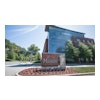Choreographing the Suppression of Tumors
When Dr. Jill Bargonetti speaks about cell division, one thing is crystal clear: This is a scientist who has the soul and sensitivity of an artist.
“I think all the sciences have a strong relation to different art forms,” she says. “Just consider the influence of the sciences on Picasso in the development of cubism.”
And the influence cuts in the opposite direction as well, says Bargonetti, who began her college career at SUNY-Purchase as a dance major and continued dancing for many years after college with a Harlem-based troupe.
“For me, biology has always had a strong relation to choreography, with the way things are constantly dividing and moving in a beautiful dance,” says Bargonetti, who has been on the Hunter College faculty since 1994.
Bargonetti’s research focuses on the p53 gene, which, when healthy, has the ability to bind to particular DNA sites in a cell and suppress the growth of tumor cells. She has been working on p53 since her first postdoctoral year, and her work has won plaudits at the highest levels.
At the age of 35, for example, she won the Presidential Early Career Award and the National Science Foundation Early Career Award. She also has been recognized by the CUNY Academy for the Humanities and Sciences, and has won the New York Voice Award, in recognition of those who have significantly improved the quality of life in New York City. This year, she received the Mayor’s Award, Young Investigator Category, from Mayor Rudolph Guiliani as well as the Outstanding Woman Scientist Award from the Association for Women in Science.
That’s quite a list of accomplishments for a woman who confesses that following her college graduation, “I couldn’t figure out what I wanted to do.” Good fortune and good advice played a role in getting her into graduate school at New York University, but the defining career moment for her came years later when she was applying for postdoctoral funding awards. “It really came home to me the amount of racism that exists around affirmative action,” Bargonetti says.
She had applied for a number of grants, including a minorities in science award from the National Science Foundation, and one for women from the American Association of University Women, then known as the Damon Runyon-Walter Winchell Award, a “hugely competitive and incredibly prestigious” award open to any cancer researcher from any country.
“Nobody thought I would get that one, but everyone was saying without a twinge, ‘You’ll get that one for the minorities — not at all realizing the level of competition for that award. And to be fair, I was thinking I’d get that one, too,” Bargonetti says. When she got an honorable mention for the NSF grant and won the Damon Runyon grant, she saw her colleagues measuring her by a completely different yardstick. “And I realized that these folks are so lost. That was when I knew I was doing science.”
Bargonetti stayed true to her personal vision when it came time to apply for teaching jobs — choosing a large, diverse public university where she could have her own lab and have an impact on students of color.
Dealing with her students’ personal issues — “their difficulties with academics, their struggles with family, the money issues because they’re living in New York on not much money, the (fact that the) undergrads are mostly first-generation college students” — is probably Bargonetti’s most daunting challenge.
But she wouldn’t have it any other way. “I wanted to be at a diverse institution, a public institution, and this is what comes with it,” she says.
— By Kendra Hamilton
© Copyright 2005 by DiverseEducation.com


















